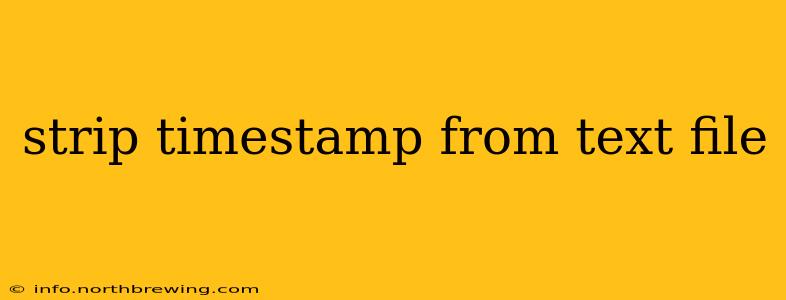Timestamps in text files can be cumbersome, especially when you need clean data for analysis or other purposes. This guide will explore various methods to efficiently remove timestamps from your text files, ranging from simple command-line tools to more sophisticated scripting techniques. We'll cover different timestamp formats and offer solutions for various operating systems.
What are the Common Timestamp Formats?
Before we delve into the removal process, understanding common timestamp formats is crucial. Timestamps can appear in various forms, including:
- YYYY-MM-DD HH:MM:SS: This is a widely used standard format (e.g., 2024-10-27 10:30:00).
- MM/DD/YYYY HH:MM:SS: Another common format, particularly in North American contexts.
- DD/MM/YYYY HH:MM:SS: Used in many parts of Europe and other regions.
- Custom Formats: Applications and systems often employ unique timestamp formats. These may include variations in separators (e.g., using dots or hyphens), inclusion of milliseconds, and different orderings of date and time components.
Recognizing the specific format in your files is the first step towards effective timestamp removal.
How to Strip Timestamps Using Command-Line Tools (Linux/macOS)
Linux and macOS offer powerful command-line tools perfect for this task. sed (stream editor) and awk are particularly useful.
Using sed
sed is a versatile tool capable of complex text manipulation. For a simple timestamp like YYYY-MM-DD HH:MM:SS at the beginning of each line, you could use:
sed 's/^[0-9]{4}-[0-9]{2}-[0-9]{2} [0-9]{2}:[0-9]{2}:[0-9]{2} //' input.txt > output.txt
This command substitutes (s/) the pattern (the regular expression matching the timestamp) at the beginning of the line (^) with an empty string ( ), effectively removing it. Replace input.txt with your file name and output.txt with the desired output file name. Remember to adjust the regular expression to match your specific timestamp format.
Using awk
awk is another powerful tool suited for text processing. A similar operation using awk could be:
awk '{gsub(/^[0-9]{4}-[0-9]{2}-[0-9]{2} [0-9]{2}:[0-9]{2}:[0-9]{2} /,""); print}' input.txt > output.txt
This command uses gsub() (global substitution) to remove the timestamp pattern from each line before printing it to the output file. Again, adapt the regular expression to your exact timestamp format.
Removing Timestamps with Python Scripting
Python offers flexibility for handling diverse timestamp formats and complex scenarios. Here's a Python script that removes timestamps from a file:
import re
def remove_timestamps(input_filepath, output_filepath, timestamp_pattern):
"""Removes timestamps matching a given pattern from a text file."""
try:
with open(input_filepath, 'r') as infile, open(output_filepath, 'w') as outfile:
for line in infile:
cleaned_line = re.sub(timestamp_pattern, '', line)
outfile.write(cleaned_line)
except FileNotFoundError:
print(f"Error: File '{input_filepath}' not found.")
# Example usage:
input_file = "input.txt"
output_file = "output.txt"
# Adjust this pattern to match your specific timestamp format
timestamp_regex = r"^\d{4}-\d{2}-\d{2} \d{2}:\d{2}:\d{2} "
remove_timestamps(input_file, output_file, timestamp_regex)
This script uses regular expressions for pattern matching, offering more control over the timestamp removal process. You'll need to adapt the timestamp_regex variable to your specific timestamp format. This approach is highly recommended for its versatility and error handling.
How to Handle Timestamps in Different Locations within the Text?
If timestamps aren't consistently at the beginning of each line, you'll need to adjust your regular expression accordingly. For instance, if timestamps can appear anywhere on a line, remove the ^ (beginning of line) anchor from the regular expression. You might also need to add word boundaries (\b) to prevent accidental removal of parts of words that coincidentally match the timestamp pattern.
What if My Timestamp Format is Highly Irregular?
For highly irregular or complex timestamp formats, consider using more advanced techniques like parsing the date and time using libraries specific to your programming language. Python's datetime module, for example, can be combined with regular expressions for robust timestamp extraction and removal.
Best Practices for Handling Text Files
Always back up your original files before attempting any modification. This ensures you have a copy of your data if something goes wrong during the process. Thoroughly test your chosen method on a small sample of your data before applying it to the entire file. Consider using version control (like Git) to track changes to your files and facilitate easy rollback if needed.
